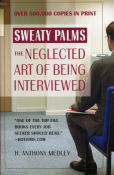| What REALLY goes on in a job interview? Find out in the new revision of "Sweaty Palms: The Neglected Art of Being Interviewed" (Warner Books) by Tony Medley, updated for the world of the Internet . Over 500,000 copies in print and the only book on the job interview written by an experienced interviewer, one who has conducted thousands of interviews. This is the truth, not the ivory tower speculations of those who write but have no actual experience. "One of the top five books every job seeker should read," says Hotjobs.com. Now available on Kindle. | |
| Under Fire: Journalists in Combat (9/10) by Tony Medley Run time 90 minutes. Clark Gable created the romantic image of the dashing war correspondent in 1942's Somewhere I'll Find You, in which he spent much of his time wooing Lana Turner, a film that typifies the lack of realism in 1940s Hollywood. Far from Hollywood, Martyn Burke has created a harrowing documentary about today's real life war correspondents and it's anything but romantic. Several correspondents are interviewed on camera and tell what covering a war is really like. Lana Turner is nowhere in sight. But what are in sight are people dead and dying, combatants trying to kill the correspondents, and the aftermath of what covering a war does to their psyche. Jon Steele, videographer for ITN London tells how he kept yelling "I need to get in this war." Burke shows footage of battles where Steele is in the middle of fights that he shot himself. He explains, "You never feel as alive as when you're staring death in the face." He goes on to say, "Framing a shot of someone dying or someone dead is obscene in some ways. When I say (in his book) that I needed those people to die or to suffer, it's not as callous as it sounds because I was trying to reach through the TV screen and grab people from their lumpy chairs and drag them into my camera, and say, 'Look, look; this is what it's like'." Burke's most compelling story is about a young girl he told to stay where she was and he'd bring her some candy. Many describe in telling detail how they are burdened by suffering from Post Traumatic Stress Syndrome. Chris Hedges, New York Times, says, "I prayed to God that if you get me out of here I'll never do this again. But that's the difference between a sane person and an insane person. A half hour later you think it's a great cosmic joke...It takes a great toll, like a drug addict. I was being broken down by war." He goes on, "It is possible to hate war, and yet be utterly bound by the experience and be unable to cope outside the ambience of war itself. Which is why war photographers and war correspondents make up a small fraternity that tend to leap from conflict to conflict to conflict." Only two journalists were killed in WWI, 63 in WWII. In the last two decades, an average of one journalist a week has been killed. This film captures the horror of war better than anything Steven Spielberg has ever done. The films here aren't on some romantic location that looks like a battlefield or on sound stages; they were taken in the middle of real battles with real bullets flying around. There is a frightening film of Finbarr O'Reilly, a Reuters photographer, in a Humvee being attacked by lots of angry people. He kept yelling, "Drive, drive, drive!" Ian Stewart, an AP journalist, shows the actual bullet that went through a window and hit him in the head in Sierra Leone. He tells about the attack that killed his cameraman, about watching people being set on fire. He says he can see and hear them screaming even now. There's a lot more here. This is a film that brings what's going on in the world much more alive than sitting in an easy chair and watching a journalist doing a standup from a war zone. This is what life is about in the many war zones of the world. St. Bride's Church in London has an entire corner dedicated to journalists who have lost their lives. As the camera scans the wall with photos of them, and one realizes that what is going on in the far corners of the world is very scary, one can't help but appreciate what the people who bring the war news home go through and how much of their joie de vivre they surrender. This is one of the better documentaries of the year.
|
|
|
|
|
